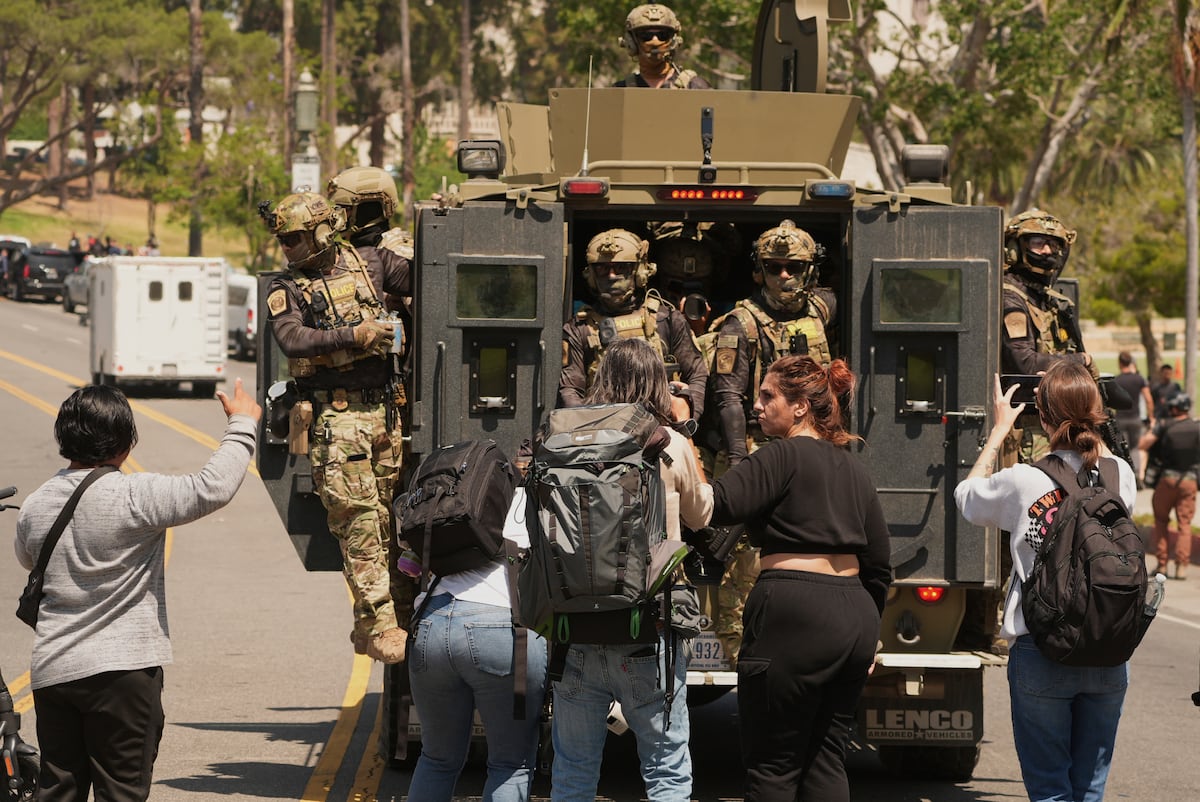That Friday in June, the helicopters of Los Angeles television networks took off, as they usually do when they’re looking for the police chases that captivate the city’s audiences. But that afternoon, they weren’t following a driver trying to escape the authorities. They were airborne to record an unprecedented massive immigration raid at a clothing factory.
From his home, about to open a bottle of wine with his wife to kick off the weekend, Javier Cabral watched in astonishment as images showed how a “La Migra” truck ran over a protester who had stopped in front of it. “The anchor at KTLA [a local television station] had the audacity to say the person had tripped. We had all just seen him pushed; it was a hit-and-run. At that moment, I tried to contact my investigative reporter, but he wasn’t answering. He was already there, and he helped document a video that changed the narrative of that event because it was so clear that it wasn’t a trip,” says the editor in charge of five employees at the small street outlet L.A. Taco. From that moment on, the digital magazine became a chronicler of Trump’s immigration crusade.
Founded in 2006 as little more than a blog reviewing restaurants and food stalls in working-class neighborhoods of Los Angeles, in 2018 it expanded to become a cultural and lifestyle outlet for the city. But the pandemic was a near-mortal blow. Since then, readership has dwindled to unsustainable levels, and the survival of the outlet, known and beloved especially in the immigrant communities of the second-largest city in the United States, was in jeopardy. Last year, they were close to laying off all four employees and closing. But since the first weekend of last June, when Los Angeles became the obsessive focus of the Trump administration’s immigration siege, everything has changed.
Now, alongside an article about a Mexican street food stand in Altadena, devastated by January’s fires, there’s the daily report on immigration raids in the city and a feature on the group hanging defiant banners on Los Angeles freeways. “I’ve been an editor during the pandemic, during Black Lives Matter, during the fires, and people have always sought out other things to read about. But with these raids, people are still very, very interested, and we’re the only ones who get some kind of coverage every day. We have our audience, and we have to keep putting out these videos and these stories, because the traditional media is talking about the Dodgers and the weather, while here we’re still witnessing historic events like federal forces disappearing people. We’re not going to stop until it stops,” Cabral says in the natural Spanglish of a proud son of East Los Angeles.
The shift may seem surprising, but for the L.A. Taco team, it was an organic transition. If they had previously covered the community’s favorite spots, now they would cover that same besieged community. Their longtime readers — their neighbors, families, and friends — unfortunately became the new protagonists of their stories. And at a time when trust in traditional media, especially among the migrant community, is at an all-time low, hearing the news from a familiar voice has been crucial.
“We’ve spent almost 20 years covering the neighborhoods, the same neighborhoods that others only care about when there’s crime. We’ve been very underground and we’ve worked with immigrant communities, and now everyone is helping us, contacting us to tell stories, and they trust us more than anyone else,” emphasizes Cabral, who personally feels vindicated in his journalistic vision so soon after facing the precipice.
The emergence of L.A. Taco as a witness to the Trump administration’s deportation crusade is part of the broader energy unleashed in communities against the president’s immigration agenda. Many of its stories depend on the complaints now published daily on various social media accounts. Accounts like mrcheckpoint, icewatchsocal, siempreunidosla, and others are dedicated to receiving and sharing live reports of sightings of immigration agents so people can avoid them. L.A. Taco, on the other hand, goes to the scene to document what happened.
“Everyone is putting aside their differences for the common cause. They’re not being difficult, saying, ‘This is my material.’ We still always credit the original author. But it’s been wonderful to see how many different publications are joining forces,” Cabral says about the collaboration that has emerged with other local media outlets like the Los Angeles Public Press.
These feelings contrast with the anger and sadness generated by the reality on the city’s streets. Also with the happiness of knowing that the media outlet is no longer just afloat, but thriving. Sustained by memberships and donations, L.A. Taco has received more funding in recent months than ever before. In recent weeks, it has hired a full-time video editor and a social media assistant, and for the first time has a budget for collaborations. And Cabral is certain and confident that he and his team can continue to be there, on the front lines, supporting the community and documenting a dark episode in the country’s history from the streets.
Sign up for our weekly newsletter to get more English-language news coverage from EL PAÍS USA Edition
